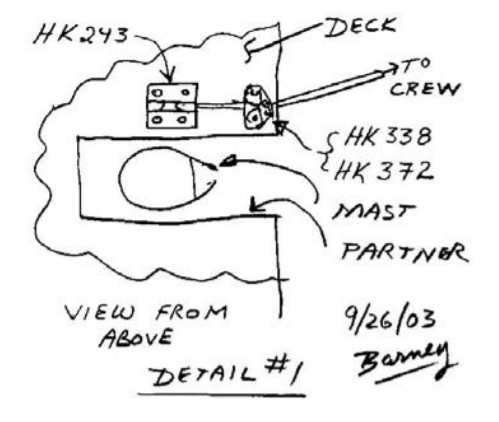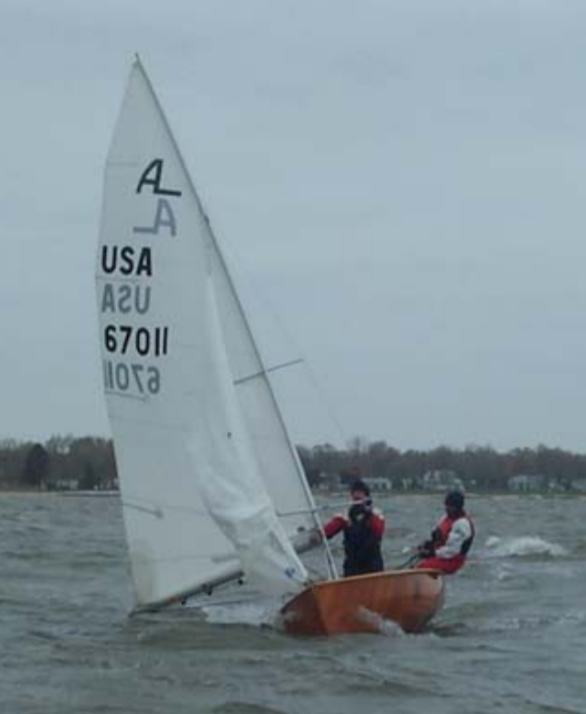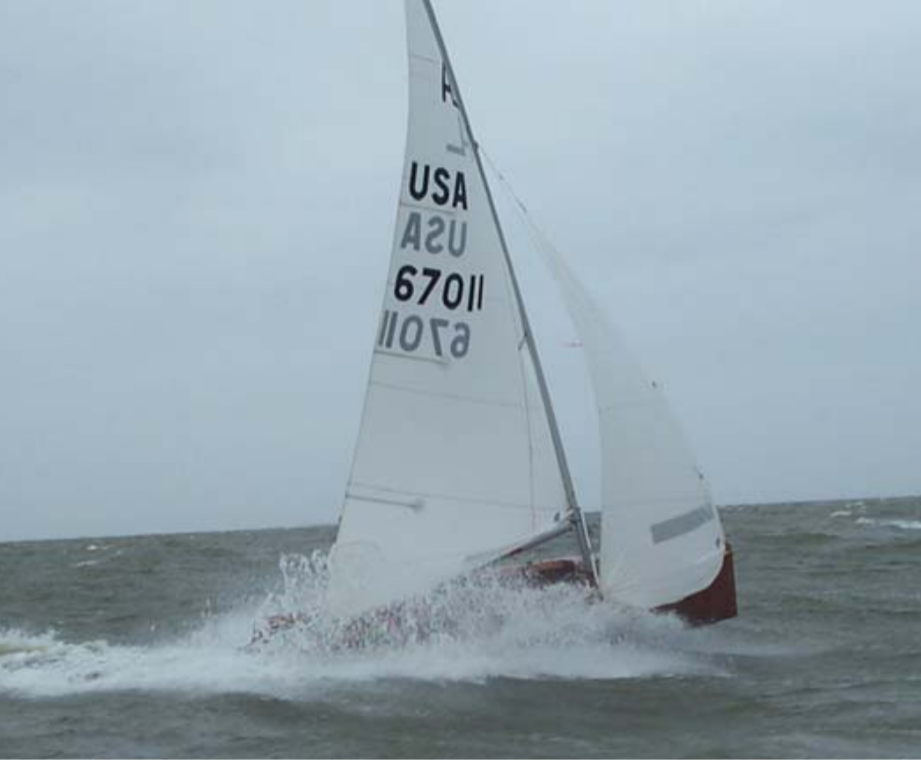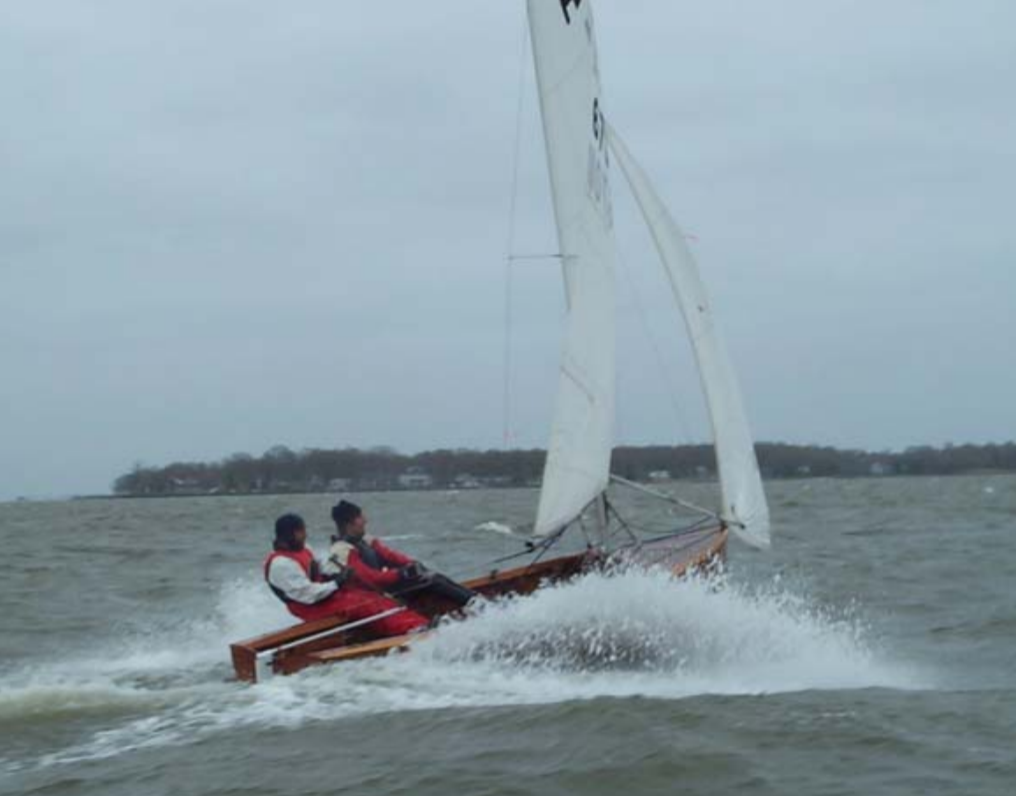The Fly Away Whisker Pole
By Barney Harris
I have been messing around with one of these up the mast pole systems, and I have to say, it’s a really nice improvement to the boat. There are two variants of this system. Both rely on a shock cord to hoist the pole to the spreaders from where it dangles while sailing upwind. Both have a third jib sheet connected to the jib clew that runs inside to pole at its lower end and exits at the top. From here the line is lead down thru the mast ring and then to some sort of a cleat. The difference is how the inboard end is constrained. The first variant has a guide formed of a tensioned line to which the upper (when stowed) or inboard (when deployed) end of the pole is connected. The pole is arranged to slide on this line with a metal loop. The second variant has no guide – the inboard/upper end of the pole assumes a position in space sprung next to the mast with the shock cord to the spreaders and the launcher line thru the mast ring. I have the second variant in 6701. I prefer the second variant because when reaching the pole makes a smaller angle to the horizontal and allows the jib to twist nicely. The guided types place too much down force on the jib while reaching and over tension the leech. Our pole design is depicted in the three sketches that follow.



After a season of use including practice and competition, I can say the boat is nicer to sail with either type – and this is from a starting point of loathing the added windage. After using the fly away pole – so dubbed by Steve Penfold of the UK, for several regattas including Internationals and UK Nationals, it has me won over for the following reasons:
1. The ease with which the crew can deploy and retract the pole. With a regular pole with clip or bayonet ends, the crew must stand up and walk forward and manually connect it to the jib clew and mast. Doing so is difficult in breezy conditions and downright dangerous in winds over 25 kts. The pole launcher system makes deploying the pole simple – pull the string and the pole is drawn to the jib clew, comes down, and booms the jib away from the boat with no stomping around in the front of the boat fumbling with a clip.
 Difficult to Deploy a Conventional Pole in High Winds.
Difficult to Deploy a Conventional Pole in High Winds.
Photo by Stephen Harris
2. The adjustability – I had been using a pole of 4’6″ in length and another of maximum length. The short pole seemed to work o.k. while reaching. I have since found that in many cases the jib will set far better at pole lengths either larger or smaller than the 4’6″ value, and so having an adjustable pole makes real sense. Using the fly away pole both main and jib can be set up optimally for any wind angle from DDW to close hauled. The task of holding the jib out to leeward is effectively replaced with the task of running the pole and sheet. A heck of a lot easier physically, but more challenging from the sailing point of view.

Main and Jib Perfectly Set and Pulling Like Mad
Photo by Stephen Harris
3. Its impossible to lose the pole. Ok not impossible – but since it’s tied to the boat by two pieces of string, its unlikely that it will go missing in a capsize or other event.
4. Crew relations – I often sail with my wife Becky. She was not a natural born sailor, so every time in the boat is an unnatural act. Anything that makes her life as crew easier is better for me. This launchable pole really shines here. No more yammering at her about
clipping the pole to the jib. She just pulls the line and that’s it. To retract the pole, just uncleat it and it goes away. The crew never has to touch it. This pole system may mean that I might even get a few more years out of Becky as crew. Extrapolating this to the
rest of the class, if it makes the crew’s task easier without fundamentally changing the boat (like a trapeze) or costing a lot, then it’s probably going to be good for the class in general.
5. One less pole – for the past year I have been carrying and using two poles – one at max length and one 4’6″ in length. With the fly away pole system I now only need to carry one. Furthermore, the pole is not at risk of being stepped on, and so it can be of thinner
wall and smaller diameter.
6. Less boat damage – I have an old woof hulled wooden Albacore. It’s nearly impossible to launch and retrieve the old pole during a series of races without gouging up the deck, seats, and hull with the damn thing. The fly away pole system pretty much eliminates this
wear and tear.
7. Less cost – the fly away pole system is slightly cheaper when compared to carrying two poles @ US$60 a pop. There are no clip end fittings – only a pressed or glued in grommet, three pulleys, a cleat, shock cord and line.
8. Small helms (not me) can get a large crew – with a launchable pole they can sail the boat in high winds while keeping the weight on the rail – and therefore compete equally with heavy helms with lighter crews. This broadens the boat’s appeal since a small helm is not penalized for being small.
How to use it:
Bear away set to wing and wing: Bear away and ease the main sheet. Release the old jib sheet. The crew should have their leeward hand on the pole launch line. The driver pulls the jib to windward using the windward sheet. The crew then pulls the pole line till the outboard end of the pole is at the clew. The crew then bats the pole to windward with their windward hand as the boat nears a DDW course; the clew and pole will swing to windward. When the pole is pointed outside the shear line, the crew should pull the launch line hand over hand until its fully deployed and cleated. The driver can then hand the windard jib sheet to the crew.
Bear away onto a reach: The crew should approach the mark with the jib sheet in the leeward / aft hand and pole launch line in the other. Ease the jib as the boat bears away and smoothly pull the launch line. Do not jerk the launch line or the pole may overshoot
and come to rest sticking past the jib, violating the 50mm rule. If this occurs, ease the launch line till the pole end clears away from the clew and re deploy slowly and smoothly. Once the pole end reaches the clew, the line can be pulled faster until it is set appropriately.
 Smokin! Photo by Stephen Harris
Smokin! Photo by Stephen Harris
Bear away gybe to wing and wing: this is really neat – the crew should have the jib sheet in leeward / aft hand and pole launch line in the other. As the boat bears away, simply deploy the pole as if one were bearing away onto a reach. The driver bears the boat away and gybes the main. When the boom comes across, continue to pull the launch line till the pole is fully deployed and cleated. Then grab the jib sheet to fill the jib.
Reach to reach gybe: David and I practiced this maneuver in high winds during the few days before Internationals this season. We were able to keep the boat fully planed off throughout the maneuver about 30% of the time. Ease the jib sheet as the boat bears away from a reach. Ease the pole launch line but do not release it all the way – the pole should be able to swing behind the jib luff – cleat it in this position. Next release the old jib sheet and pull in on the new one. Pull the launch line and adjust the jib sheet until the pole is set correctly.
Run to run gybe: Gybe the main first. Then release the old jib sheet and ease the pole launch line half way. Snap the new jib sheet and bat the pole to windward such that the clew and outboard pole end are brought to the new windward side. The Helm can pull the windard sheet if its not too windy. The instant the pole outboard end is pointed outside the sheer line, the crew should pull it as fast as they can until it is fully deployed and cleated and then reach for the jib sheet.
Transition to Upwind Sailing: When rounding the leeward mark, all one has to do is release the pole launch line and sheet the jib, no matter what angle of sail the boat is on. One can wait until the boat has begun to head up to round the mark, thereby keeping the jib deployed and pulling for the longest possible time. Sweet!
